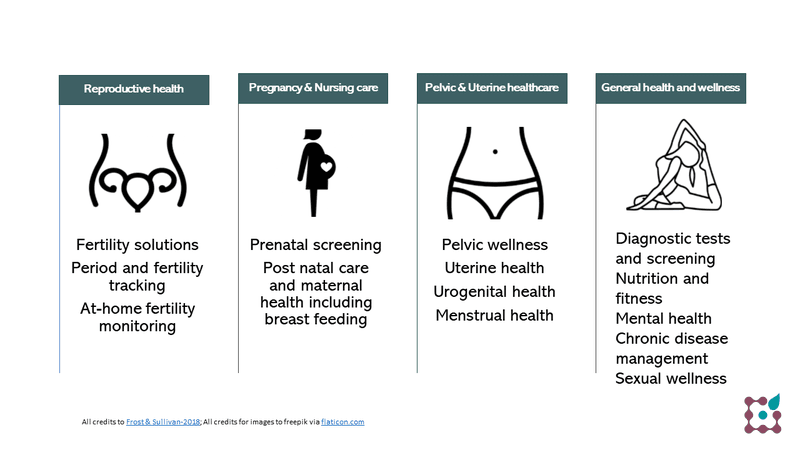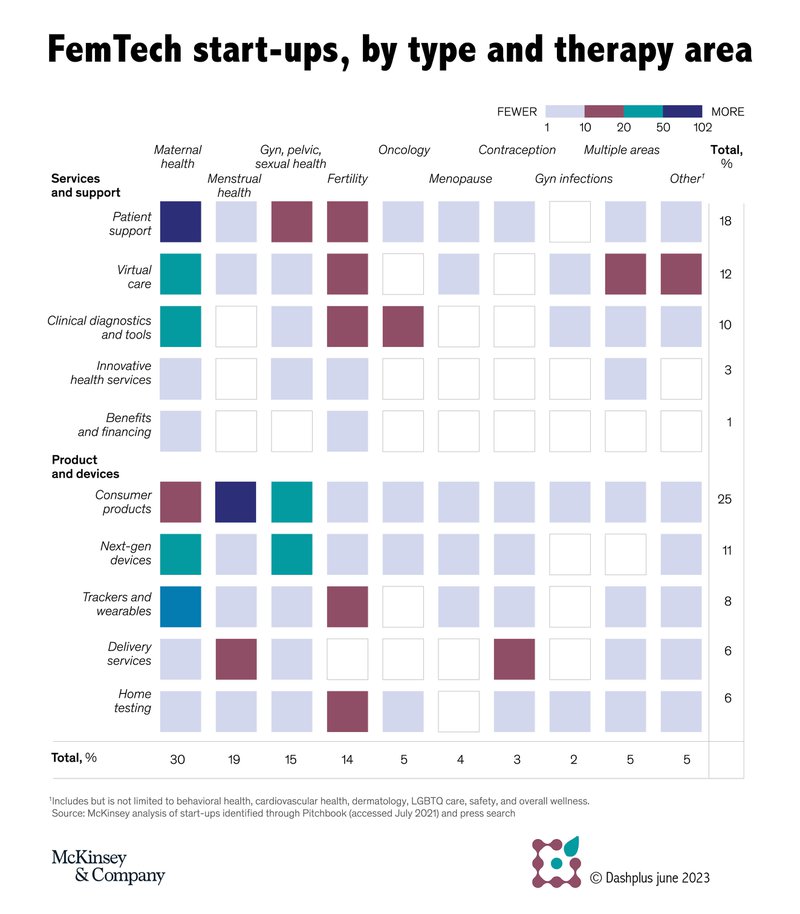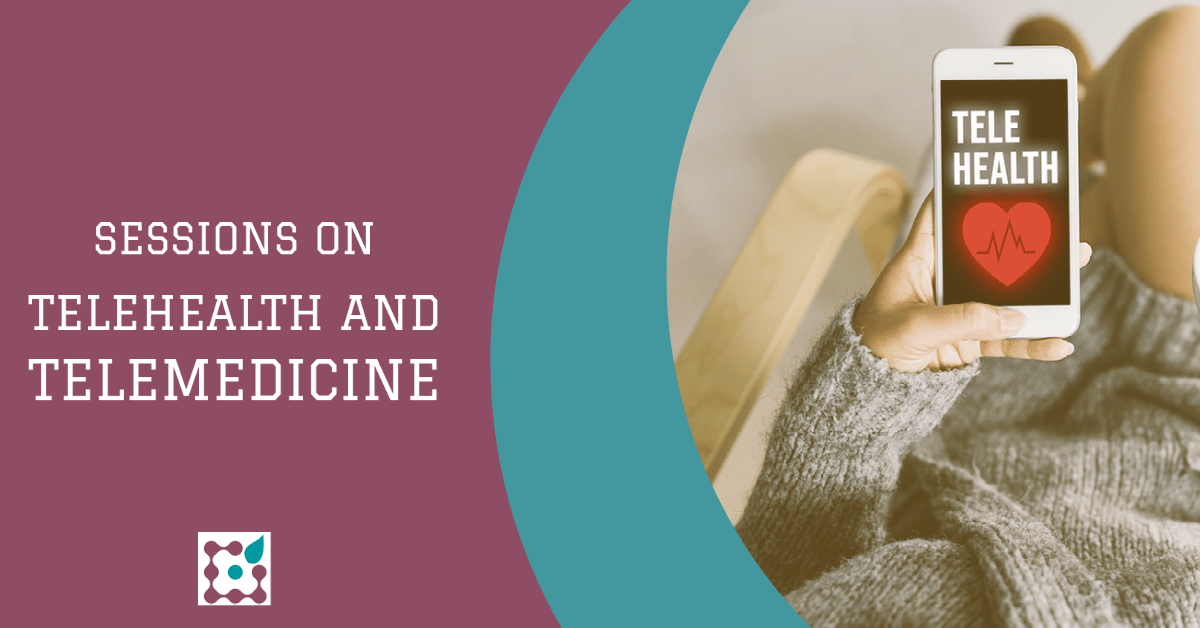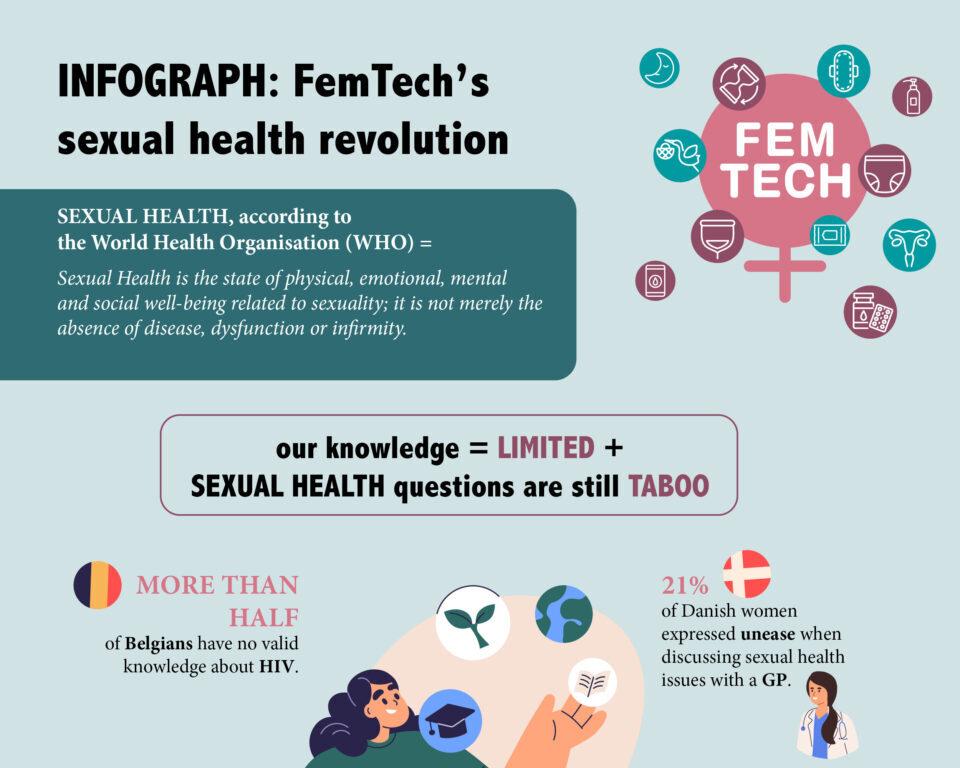Recently, the UN Women’s organization rightly pointed out the powerful impact femtech can have on sexual health and rights worldwide.
There is a huge taboo on sexual health issues. We need more powerful health education. And the need for personalized prevention, diagnosis and treatment of all things sexual health is a perfect fit with digital or hybrid female health.
They will gain attraction from insurers, employee benefits and other health innovators.
Dive into sexual health, the untapped segment of Femtech.
What about our sexual health?
“Sexual Health is the state of physical, emotional, mental and social well-being related to sexuality; it is not merely the absence of disease, dysfunction or infirmity.” (WHO)
As awareness for mental and physical health continues to grow, there is a gradual shift towards a more holistic approach to healthcare. The impact of sexual health, on the other hand, often remains overlooked. The WHO emphasizes that sexual health plays a fundamental role in the well-being of individuals and even economies.
Limited knowledge and taboo
Although sex seems to be all over the place, it’s striking how limited our knowledge of sexual health is and how sexual health questions (on normal functioning of our body and sexual health, disease symptoms and risks, services and treatments, self-care, …) keep on being taboo:
- 76% of US female teenage students indicate ‘they are thought more about the biology of frogs than the human female body at school’ (*)
- more than half of Belgians have no valid knowledge about HIV, mostly younger (under 34) and older (over 65) people
- 21% of women in a Danish study expressed unease when discussing sexual health issues with general practitioners and 10% reported discomfort when speaking to gynaecologists.
- more than 50% of young women in the UK rely on search engines for information on menstrual health, a recent survey of Flo Health indicates and
- 59% do not know you can catch an STI without having sex
This was also confirmed at the Wonca Europe conference on primary health this year, where a packed room discussed the difficulty of reaching out to women with sexual health issues and GP’s indicated ‘being responsible for everything’..
Here is where FemTech could help
Back in 2018 I wrote a blog on 'The rise of Femtech in Europe’ sharing more on the digital solutions to female health needs, why they are important and here to stay.
Within Femtech, we typically indicate 4 subsegments :
- general health and wellness
- healthcare and diagnostics
- reproductive health
- pregnancy and family care
With mental health, longevity and sexual health solutions situated within general health and wellness.

Today, FemTech is a rapidly growing industry focused on developing technologies & digital solutions to improve women's health. It’s experiencing remarkable growth. While there were about 380 companies before 2015, we counted over 1,400 already in 2022. Over 100 companies are founded annually.
According to FemTech Analytics, the global FemTech market size reached $25.3 billion in 2021 and is projected to expand to $75,1 billion in 2025 and $97.3 billion by 2030.
In 2022, the majority of FemTech companies is based in the USA, accounting for 51% of all companies. Europe emerges as the second-largest region, accounting for 27%. The majority of these European companies are based in the UK. With start-ups like Syrona Health, a virtual clinic personalized gynecological support & Hormona, a data-driven approach to hormone tracking, as examples.
But also France (12% of European FemTech companies), Switzerland (10%) and Germany (9%) are in this list.
Sexual health as part of Femtech
While Femtech has made significant steps in pregnancy and fertility solutions, there remains a huge potential in addressing other critical female health issues, including sexual health.
The segment ‘Sexual health’ currently represents 9% of TechFem companies worldwide.
Mc Kinsey indicated sexual health is one of the white spaces in FemTech with needs for education and patient support, next-gen devices, innovative services and benefits and financing, especially for gyn infections.

It touches on one of the pain points: still only 4% of R&D in healthcare is spent on women’s health topics.
However, there are reasons to believe that sexual health soon will no longer be an untapped segment.Here’s why.
STD’s, HPV and cervical cancer
First, when talking about sexual health, tackling sexual transmitted diseases (STD’s), HPV and cervical cancer have the biggest impact:
- With over 1 million new cases acquired daily in the United States alone, the prevalence of sexually transmitted diseases (STDs) is alarming.
- In 2020,the WHO estimated 374 million new infections with 1 of 4 STD’s: most frequent chlamydia & gonorrhea. Direct medical costs for eight major STDs have been estimated at $16.7 billion in the United States.
- STD’s are often asymptomatic which leads to non-diagnosis. This has a profound impact on sexual and reproductive health since it can lead to further infections and reproductive problems and thus significant healthcare costs.
- Screening, testing and personalised education are needed to reduce that risk, but there’s the threshold of the HCP visit for testing and treatment currently-as indicated before.
- We lack HCP everywhere nowadays, which further puts pressure on accessibility for these kind of topics
- There were 43 million HPV infections in 2018, many among people in their late teens and early twenties.
- worldwide, only 15% of girls had a first dose of HPV vaccin in 2022.
- The human papillomavirus (HPV) is associated with multiple cancers in women and men, with cervical cancer (women) and laryngeal and oral cavity cancer (men) being the most widespread.
- Vaccination and screening is the most important strategy to prevent these cancers, but they vary from country to country. And even if you’re vaccinated, regular cervical cancer testing is necessary.
- An estimate of national expenditures for Cervix Uteri cancer care accounts for $2.3 billions of dollars per year.
Hybrid care to bridge the gap
Second, point-of-care (POC) tests can be part of the solution. They can provide quick diagnosis and early treatment of infections, to improve the prevention and the control of STDs.
“Combining point-of-care tests with telehealth, can lower the barrier to testing and improve overall accessibility”
This is already done by TBD Health in Las Vegas, an in-person and virtual sexual health clinical team. Recently, the Visby Medical test, which is used by clinics in the US-Mexico region, received FDA clearance.
In the UK, LVNDR health offers seamless, inclusive and remote care for the LBTQ+ community. People can order a free test kit and send it back by mail, then book an appointment with an LBTQ+ informed clinician and wait for them to call via the app. Next, LVNDR prescribes and dispatches medication if needed. LVNDR cooperates with NHS.
Swiss Testmate provides home tests that are able to give results for 4 common STDs, in just a few minutes and treatment via their app.
And Belgian start-up MEEP is currently developing home tests for detection of chlamydia. Their aim is to close the loop with digital care: by 1) consulting a clinician through a teleconsultation 2) measure at home with the Meep device and 3) receive therapy afterwards.
This shows opportunities for hybrid care within sexual health. Combining point-of-care tests with telehealth, can lower the barrier to testing & improve overall accessibility.
Femtech’s sexual health revolution
Third, Femtech companies keep on building solutions for both general health care (including health promotion, infection testing and cervical cancer testing and treatments) and sexual health (more focused on sexual education tools, preventing, testing and treatment of STD’s)..
Diagnostics are an important product type within both subsegments, together with consumer products, wearables and apps. But also telehealth is important, mainly within the general health care segment of female health.
They are also revolutionising sexual health:
- Mobile ODT (Israël): building AI-based medical technologies for cervical cancer screening and treatment
- Remi Health (Germany): self-testing for STI’s + digital end-to-end clinic. Test kit @home, digital results and doctors consultation
- iPlaySafe (UK): at-home STI-testing kit integrated with an app. Do pro-active testing and share your verified sexual health status.
- Nanopath (UK): molecular diagnostics company disrupting traditional testing methods.
Health insurers discovering sexual health
Finally,health insurers in Europe are slowly discovering the importance of the topic and start services on female health.
Belgian sick fund CM, for example, launched an OnlyFans channel to improve sexual education. While counterpart Helan hosted an open innovation event on menopause.
In the UK, Bupa health offers sexual health checks as pay-as-you-go-services since 2022, also for people who don’t have full health care insurance.
And the very inspirational campaign ‘sexual health matters’ by NHS Derbyshire county Council offers free sexual health services @home in the UK. Think of condoms by post, virtual sexual health promotion advice by doctors, a sexual health chatbot and STI-testing and treatment at home. Due to the success of the service, waiting times for the booking line are already full..
Health benefits are important to all generations of employees, but especially to younger ones. As more and more companies are offering fertility and family planning benefits, we might expect them to also include sexual health benefits in the future.
Why is this important?
- Sexual health issues are thé untapped segment in female health: 21% of women feel uncomfortable talking to a gynecologist about sexual issues, which sometimes leads to non-diagnosis
- Integration of hybrid care models combining telehealth and POC testing, for example Meep chlamydia test, can lower barriers to testing and early detection, providing a promising outlook for the future on women's health as well as on health expenditures.
- Health insurers in Europe are slowly discovering the importance of the topic and start creating services.
Want to tap into more insights on FemTech and digital health markets? Join our newsletter list 👉
Thanks to Gianna V, member of the dashplus team and co-author of this blog.











